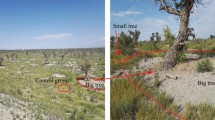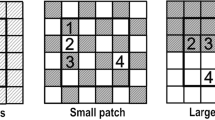Abstract
Many studies carried out during these last few years have focused on the factors influencing plant diversity in species-rich grasslands. This is due to the fact that these ecosystems, among the most diversified in temperate climates, are extremely threatened; in some areas, they have almost disappeared. The re-establishment of these habitats implies to know the living conditions of the associations to be recreated. Very often, the typical species of these communities have become so rarefied that the seed bank or the seed rain are not sufficient to recreate the plant community. Most of the time, to achieve the restoration of these communities, they have to be totally recreated by sowing. For the restoration or the maintenance of the community, the soil chemical characteristics have also to be appropriate or if not modified. This research tends to establish a relation between some soil chemical factors and the plant diversity of a great number of stations. This research has illuminated the relationship between soil extractable phosphorus and potassium and plant diversity. Over 5 mg of phosphorus per 100 g of dry soil (acetate + EDTA extraction), no station containing more than 20 species per 100 m2 has been found. The highest number of species is found below the optimum content of the soil for plant nutrition (5–8 mg P/100 g). Concerning the potassium, the highest number of species is found at 20 mg/100, a value corresponcing to an optimum content of the soil for plant nutrition. High potassium contents, in opposition to phosphorus contents, are thus compatible with high values of diversity. Other factors (i.e. pH, organic matter, total nitrogen and calcium) do not show so clearly a relation with plant diversity. Excess of N–NO3 is known for its negative effect on the diversity of plant communities. In these environments, apart from the atmospheric deposits which can be important in some areas, N–NO3 is derived mainly from the symbiotic fixation of atmospheric nitrogen by legumes as well as from the mineralization of the organic matter of the soil. It is possible that, when in small quantities, the available soil phosphorus could be a limiting factor of the N–NO3 supply by these two sources. In this hypothesis, nitrogen would remain the main element limitating plant diversity but its availability would be controlled by phosphorus.
Similar content being viewed by others
References
Al-Mufti M M, Sydes C L, Fumess S B, Grime J P and Band S R 1977 A quantitative analysis of shoot phenoiogy and dominance in herbaceous vegetation. J Ecol. 65, 759–791.
Amador J A and Jones R D 1993 Nutrient limitations on microbial respiration in peat soils with different total phosphorus content. Soil Bid. Biochem. 25(6), 793–801.
Baines R N, Griesharber-Otto J and Snaydon R W 1983 Factors affecting the performance of white dover in swards. In Efficient Grassland Farming. Ed. A J Corrall. pp 217–222. Proc. 9th General Meeting of the European Grassland Federation. Occasional Symposium no. 14. BGS, Reading, UK.
Baldock D 1990 Possible policy options and their implication for conservation. In Grassland Management and Nature Conservation. Eds. R J Haggar and S Peel. pp 167–176. Occasion Symposium no. 28. BGS, Reading, UK.
Berendse F, Oomes M J M, Altena H J and Elberse W T 1992 Experiments on the restoration of species-rich meadows in the Netherlands. Biological Conservation 62, 59–65.
Bobbink R 1991 Effects of nutrient enrichment in dutch chalk grassland. J. Appl. Ecol. 28, 28–41.
Braun-Blanquet J 1932 Plant Sociology. The Study of Plant Communities. McGraw-Hill, New York, London. 439 p.
Cadish G, Giller K E, Urquiaga S, Miranda C H B, Boddey R M and Schunke R M 1994 Does phosphorus supply enhance soil-N mineralization in Brazilian pastures? Eur. J. Agron. 3(4), 339–345.
Caradus J R and Snaydon R W 1988 Effect of grass competition, cutting frequency, and soil type on the phosphorus response of semi-natural populations of white clover. NZ J. Agric. Res. 31, 95–103.
Cheshire M V and Chapman S J 1996 Influence of the N and P status of plant material and of added N and P on the mineralization of C from 14C-labelIed ryegrass in soil. Biol Fertil. Soils 21, 166–470.
Commission des sols de Wallonie 1988 Rapport d'activité de la periode 1987–1988. Service de la science du sol. Faculté des sciences agronomiques de l'Etat à Geinbloux. 31 p.
Cottenie A, Kiekens L and Verloo M 1975 Principles of soils and substrate analysis with regards to mobility of nutrient elements. Pédologie 25(2), 134–142.
Dunlop J and Hart A L 1987 Mineral nutrition. In White Clover. Eds. M J Baker and W M Williams. pp 153–173. C.A.B. International, Wallingford, UK.
Elisseou G C, Veresoglou D S and Mamolos A P 1995 Vegetation productivity and diversity of acid grasslands in nothern Greece as influenced by winter rainfall and limiting nutrients. Acta Oecol. 16(6), 687–702.
Gigon A and Leutert A 1996 The dynamic keyhole-key model of coexistence to explain diversity of plant in limestone and other grasslands. J. Veg. Sci. 7, 29–40.
Grime J P 1979 Plant Strategies and Vegetation Processes. John Wiley & Sons, Chichester. 186 p.
Hart A L, Jessop D L and Galpin J 1981 The response to phosphorus of white clover and lotus inoculated with rhizobia or given KNO3. NZ J. Agric. Res. 24, 27–32.
Hart A L 1982 The distribution of phosphorus and nitrogen in white clover and lotus inoculated with rhizobia or given mineral nutrition. In Plant Nutrition. Ed. A Scaife. pp 221–226. Proc. 9th International Plant Nutrition Colloquium. Farnham Royal, Commonwealth Agricultural Bureaux, UK.
Holford I C R and Gleeson A C 1976 White clover responses to phosphorus and sulphur on granitic soils. Aust. J. Exp. Agric. Animal Husb. 16, 234–239.
Hue N V and Adams F 1984 Effect of phosphorus level on nitrification rates in three low-phosphorus ultisols. Soil Sci. 137(5), 324–331.
Läkanen E and Erviö R 1971 A comparison of eight extractants for the determination of plant available micronutnents in soils. Acta Agral. Fenn. 123, 223–232.
Lambinon J, Dc Langhe J-E, Delvosalle L and Duvigneaud J 1992 Nouvelle flare de la Belgique, du Grand-Duchè de Luxembourg, du Nord de la France et des Régions voisines (Ptéridophytes et Spermatophytes), 4th ed. Editions du Patrimoine du Jardin national de Belgique, Meise. 1092 p.
Mamolos A P, Elisseou G K and Veresoglou D S 1995 Depth of root and activity of coexisting grassland species in relation to N and P additions, measured using nonradiactive tracers. J. Ecol. 83, 643–652.
Mars R H 1993 Soil fertility and nature conservation in Europe, theoretical considerations and practical management solutions. Adv. Ecol. Res. 24, 241–300.
McDonald A W, Bakker J P and Vegelin K 1996 Seed bank classification and its importance for the restoration of species-rich flood-meadows. J. Veg. Sci. 7, 157–164.
Marschner H 1995 Mineral Nutrition of Higher Plants, 2nd ed. Academic Press, London. 889 p.
Mountford J O, Lakhani K H and Kirkham F 1993 Experimental assessment of the effects of nitrogen addition under hay-cutting and aftermath grazing on the vegetation of meadows on a Somerset peat moor. J. Appl. Ecol. 30, 321–332.
Munevar F and Wollum I I 1977 Effects of the addition of phosphorus and inorganic nitrogen on carbon and nitrogen mineralization in andepts from Colombia. Soil Sci. Soc. Am. J. 41, 540–545.
Oksanen J 1996 Is the humped relationship between species richness and biomass an artefact due to plot size? J. Ecol. 84, 293–295.
Oomes M J M, Olff H and Altena H J 1996 Effects of vegetation management and raising the water table on nutrient dynamics and vegetation change in a wet grassland. J. Appl. Ecol. 33, 576–578.
Russel E W 1973 Soils Conditions and Plant Growth. Longman, New York. 849 p.
Shannon C E 1948 A mathematical theory of communications. Bell Sys. Tech. J. 27, 379–423, 623–656.
Spellerberg I F 1991 Biogeographical basis of conservation. In The Scientific Management of Temperate Communities for Conservation. Eds. I F Spellerberg, F B Goldsmith and M G Morris. pp 293–322. Blackwell, Oxford, UK.
Tallowin J R B, Mountford J O, Kirkham F W, Smith R and Lakhani K H 1994 The effect of inorganic fertilizer on a species-rich grassland — implications for nature conservation. In Grassland and Society. Eds. L 't Mannetje and J Frame. pp 332–337. Proc 15th General Meeting of the European Grassland Federation. Wageningen, NL.
Tallowin J R B, Janssens F, Peeters A, Smith R E N, Bakker J P, Bekker R M, Verweij G L, Fillat F and Oomes M J M 1997 Relationship between soil nutrients and plant diversity in grasslands: definition of limits for the maintenance and the reconstruction of species-rich communities. In Management for Grassland Biodiversity. pp 315–322. Proc. International Occasional Symposium of the European Grassland Federation, Warsaw-Lomza, Poland.
Thompson K, Bakker J P and Bekker R M 1997 Soil Seed banks of NW Europe; Methodology, Density and Longevity. Cambridge University Press, Cambridge.
Vermeer J G and Verhoeven J T A 1987 Species composition and biomass production of mesotrophic fens in relation to the nutrient status of the organic soil. Acta Oecol. 8(22), 321–330.
Walkley A and Black I A 1934 An examination of the Degtjareff method for determining soil organic matter, and a proposed modification of the chromic acid titration method. Soil Sci. 34, 29–38.
Wheeler B D and Giller K E 1982 Species richness of herbaceous fen vegetation in Broadland, Norfolk in relation to the quantity of above-ground plant material. J. Ecol. 70, 179–200.
Wheeler B D and Shaw S C 1991 Above-ground crop mass and species richness of the principal types of herbaceous rich-fen vegetation of lowland England and Wales. J. Ecol. 79, 285–301.
Willems J H and van Nieuwstadt M G L 1996 Long-term after effects of fertilization on above-ground phytomass and species diversity in calcareous grassland. J. Veg. Sci. 7, 177–184.
Willems J H, Peet R K and Bik L 1993 Changes in chalk-grassland and species richness resulting from selective nutrient additions. J. Veg. Sci. 4, 203–212.
Wilson S D and Shay J M 1990 Competition, fire, and nutrients in a mixed-grass prairie. Ecology 71(5), 1959–1967.
Author information
Authors and Affiliations
Rights and permissions
About this article
Cite this article
Janssens, F., Peeters, A., Tallowin, J. et al. Relationship between soil chemical factors and grassland diversity. Plant and Soil 202, 69–78 (1998). https://doi.org/10.1023/A:1004389614865
Issue Date:
DOI: https://doi.org/10.1023/A:1004389614865




